Directly outside the west front of St Paul’s Cathedral stands this statue of Queen Anne …

It was during her reign that the rebuilding of St Paul’s, after the 1666 Great Fire, was completed. The original statue was erected in 1712, an integral part of the design. It was damaged, deteriorated and was replaced with this copy in 1886.
It’s difficult not to feel sorry for Anne. Her personal life was marked by the tragedy of losing 18 children (including twins) through miscarriage, stillbirth and early death. Two of her daughters, Mary and Anne Sophia, died within days of each other, both aged under two years, of smallpox in 1687.
One little boy, William Duke of Gloucester, survived but within weeks it became clear that he was an ill child. He suffered from debilitating convulsions, struggled to walk and died in 1700 at the age of 11. Here is a touching portrait of them both …
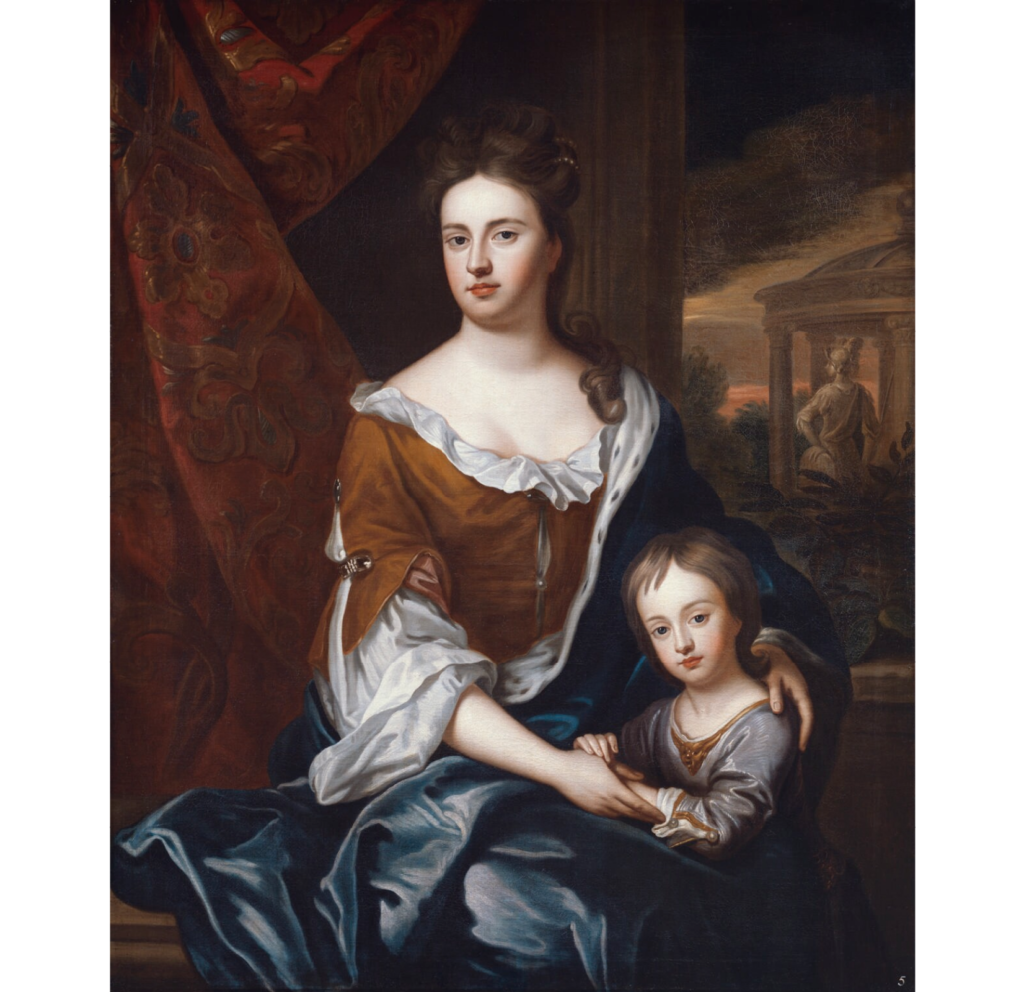
Oil on canvas, based on a work of circa 1694 : © National Portrait Gallery, London.
Her marriage, to Prince George of Denmark, was a devoted, loving and faithful one and she was devastated by his death in October 1708. By all accounts he was rather a dull character, one contemporary thought him ‘of a familiar, easy disposition with a good sound understanding but modest in showing it … very fat, loves news, his bottle and the Queen’. Another, more cruelly making fun of George’s asthma, said the Prince was forced to breathe hard in case people mistook him for dead and buried him.
Anne was given to intense female friendships, first with the Duchess of Marlborough, whose husband’s victories over the French lent the Crown reflected glory, and later with Abigail Masham.
These were explored to some dramatic effect in the film The Favourite starring Olivia Colman – the official trailer is brilliant and you can view it here. Watch out for Emma Stone’s magnificent snort.
Here’s the Queen again in close up, gazing imperiously down Ludgate Hill …
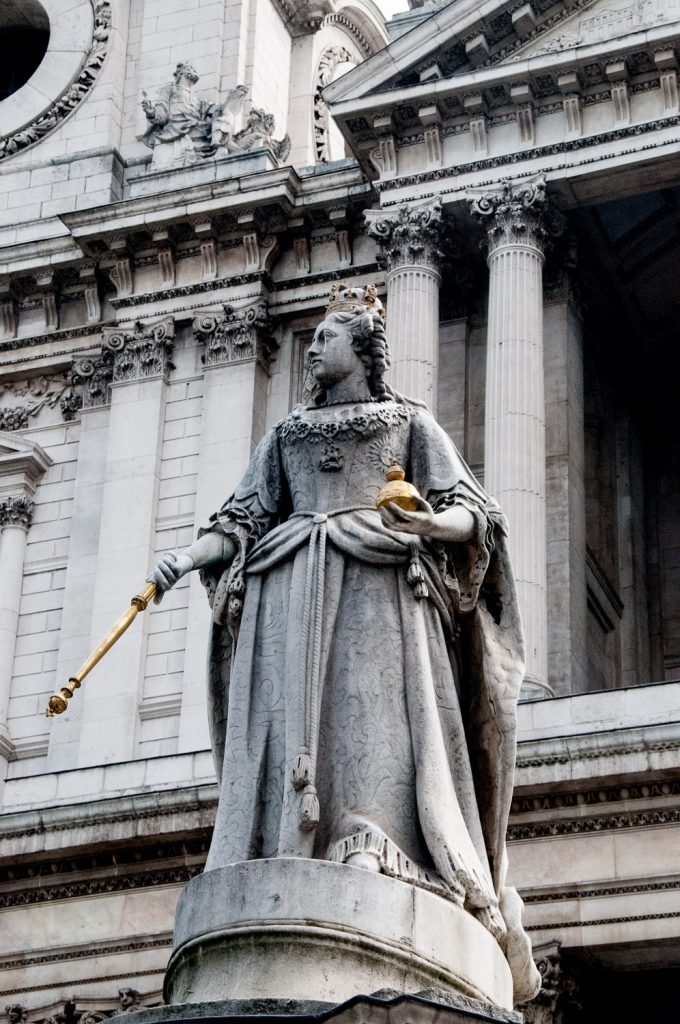
Wearing a golden crown, she has the Order of St George around her neck, a sceptre in her right hand and the orb in her left. The four allegorical ladies around the base of the statue represent England, France, Ireland and North America, as at that time Anne considered herself to be queen of them all.
With her left hand, Britannia supports a cartouche with the royal arms …

Holding a trident in her right hand she also wears Minerva’s breastplate adorned with a gorgon mask as if it were a sash. Minerva was the Roman Goddess of wisdom and the sponsor of arts, trade and strategic warfare.
France is seated with her eyes lowered and wearing a helmet with three fleurs-de-lis on the visor surmounted by a plume sweeping backwards …

Her right hand rests on a substantial truncheon and her left clasps a mural crown.
In my opinion America is the most interesting and I have written about her before …

She wears a feathered head-dress and skirt whilst her left hand grasps a metal bow. Her right hand may once have held an arrow.
What fascinates me, however, is the creature by her feet which resembles a rather angry Kermit the frog (alongside some poor chap’s severed head) …
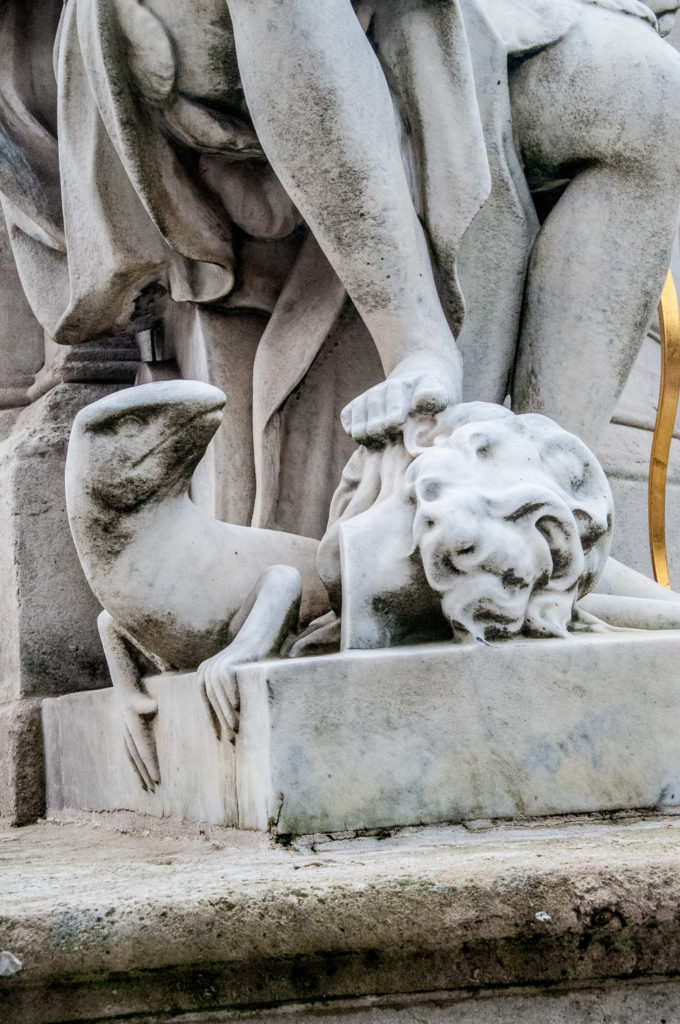
In 1712, this is what the original sculptor Francis Bird imagined an alligator would look like. A contemporary description of the statue states …
There is an allegator creeping from beneath her feet; being an animal very common in some parts of America which lives on land and in the water.
A pretty young Ireland is seated at the back of the monument with a harp resting on her right thigh …

Anne was 37 years old when she became queen in 1702. At her coronation she was suffering from a bad attack of gout and had to be carried to the ceremony in an open sedan chair with a low back so that her six-yard train could pass to her ladies walking behind. Her medical conditions made her life very sedentary and she gradually put on a lot of weight. She died after suffering a stroke on Sunday 1st August 1714 at the age of 49.
The size of her coffin, on the far right, tells a story …
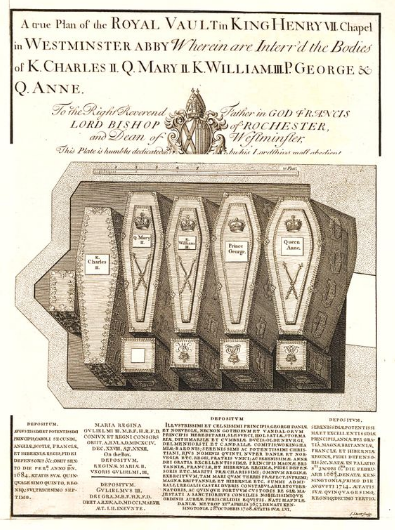
She left no clear will: perhaps her fear of death meant she could not bring herself to sign one, yet she left her country changed forever. She created the United Kingdom as we know it today and prepared the way for the Hanoverians, the dynasty of the Georgians, who ruled Britain until Queen Victoria. In fact Queen Anne worked with a new kind of monarchy that we recognise today. No longer would monarchs rule by the divine right of kings, a belief that led her grandfather, Charles I, to the scaffold. Instead, monarchs ruled in conjunction with parliament. History seems to have been rather unkind to her and this article in History Extra attempts to set the record straight.
In 1897 Queen Victoria celebrated her Diamond Jubilee and a service was held in the open air outside St Paul’s …
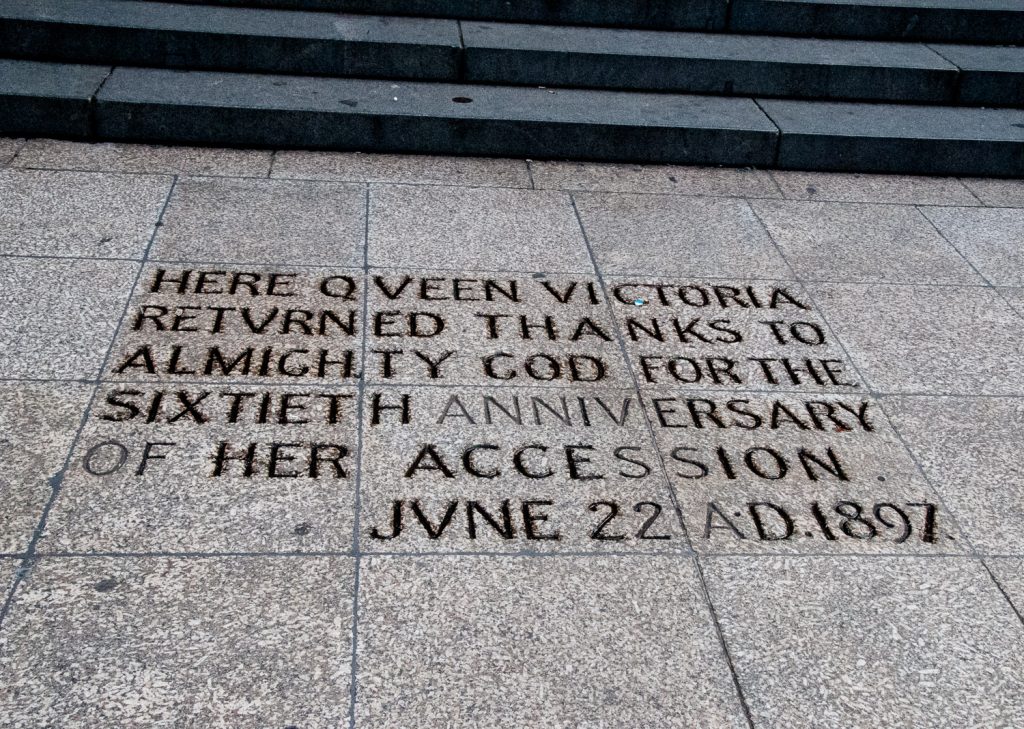
Due to her frailty she remained in her carriage throughout the ceremony where the clergy joined her, surrounded by dignitaries and troops from around the Empire …
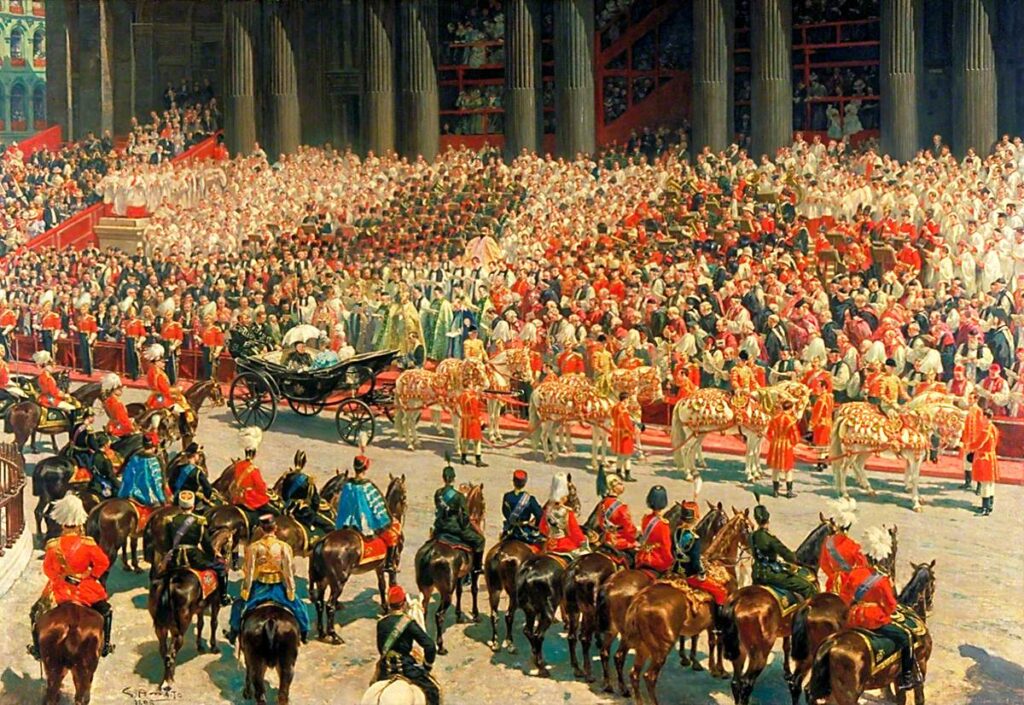
You can just see, in the bottom left hand corner, the railings that surround Anne’s statue.
Its position is clearer in this photograph …
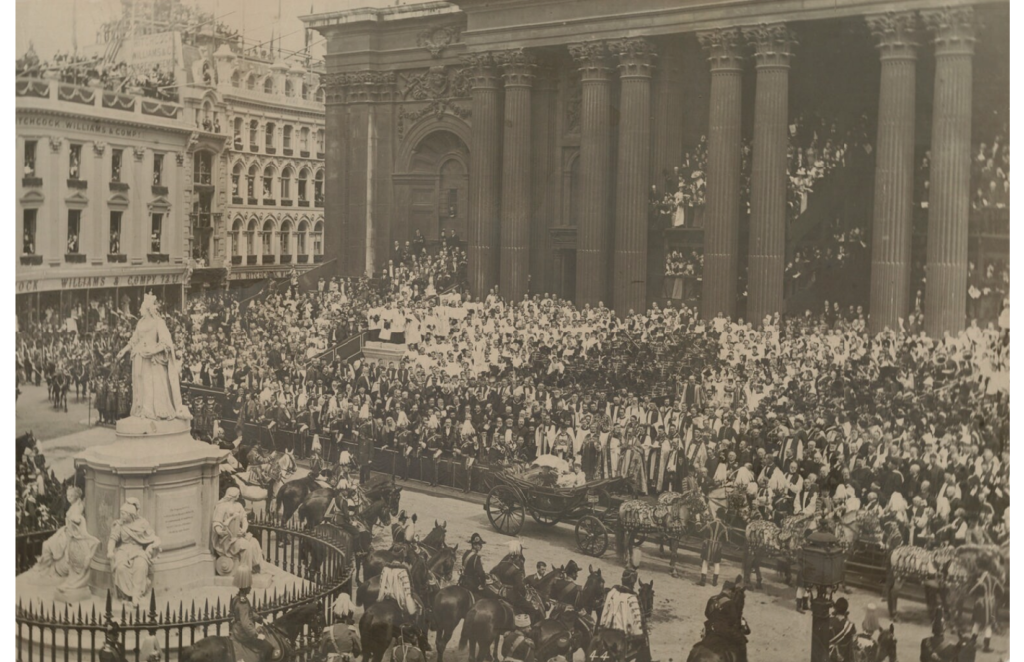
At one point when the celebrations were being planned it was suggested that Queen Anne’s statue be moved but Victoria was horrified …
‘Move Queen Anne? Most certainly not’ Victoria declared, ‘Why it might some day be suggested that my statue should be removed, which I should much dislike!’
I want to say a little more about why the original 1712 statue was replaced by a copy in 1886. As far back as June 1823 it was described in The Gentleman’s Magazine as being in a ‘ruinous state’. The article went on …
It has been twice attacked by lunatics, first in January 1743, when the man broke off the sceptre … and again in 1769 when a Lascar who, when apprehended, attempted to stab the watchman. In both cases it appeared, upon examination before a Magistrate, that the men were out of their senses. … The Lascar had the Globe in his hands as he was climbing over the iron rails.
The poor Lascar was consigned to the notorious Bedlam Hospital for the insane – a very long way from home.
Anne and her companions were acquired by the writer Augustus Hare, repaired, and moved to the grounds of his country house, Holmhurst St Mary near Hastings. The house has since been used as a school and a convent, and is now subdivided into private living accommodation. I found this picture of the original statues on the internet and they have obviously been comprehensively vandalised – very sad …
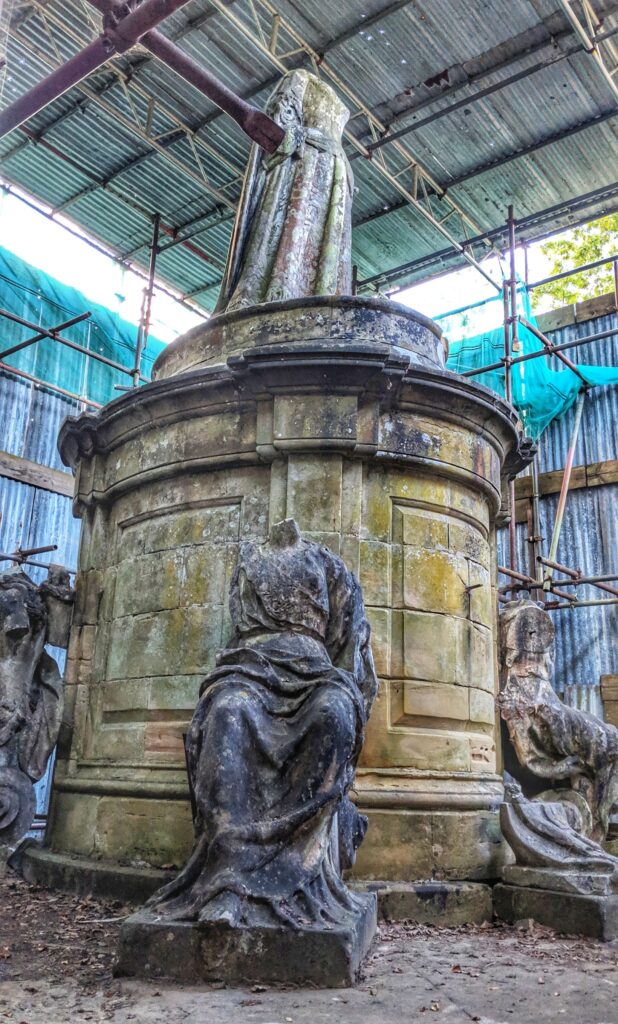
You can find an excellent article about their acquisition, removal and history here.
Remember you can follow me on Instagram :
